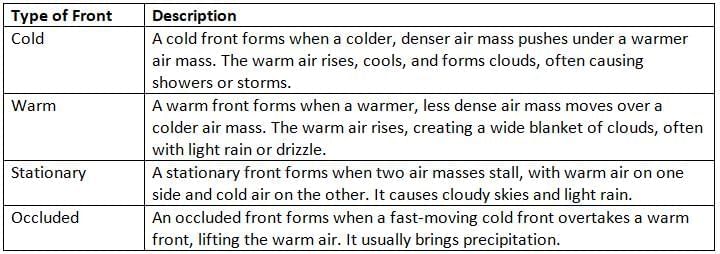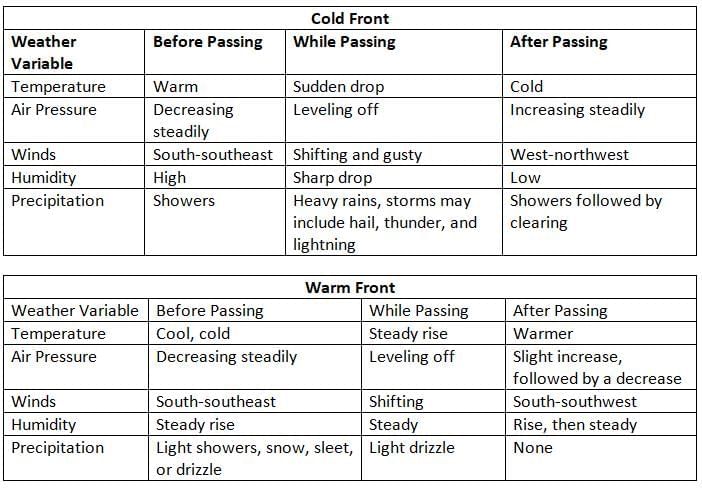Weather Patterns Chapter Notes | Geography for Grade 6 PDF Download
Introduction
Weather is something we experience every day, like sunshine, rain, or wind. The chapter "Weather Patterns" helps us understand what causes the weather to change and how it affects our lives. It explains how different factors, like temperature, air pressure, and humidity, work together to create the weather we see. We will also learn about air masses, pressure systems, fronts, and how meteorologists predict the weather using tools like Doppler radar. This chapter shows how the atmosphere is always moving and changing, impacting the weather around us.
How is weather described?
- Weather reports give information to help us plan our day, like whether we need an umbrella or sunglasses.
- Weather is described using numbers and special terms to explain conditions like temperature, rain, or wind.
- Meteorologists use specific factors to describe weather, such as temperature, air pressure, humidity, precipitation, and wind speed.
Weather Factors
- Weather is the condition of the atmosphere at a specific place and time, including short-term changes.
- Meteorologists are scientists who study and predict weather using different variables.
- Weather variables include:
- Temperature: Measures how hot or cold the air is, usually in degrees Celsius or Fahrenheit.
- Air Pressure: The weight of air molecules pressing down on Earth, measured in millibars.
- Humidity: The amount of water vapor in the air, often shown as a percentage.
- Precipitation: Any form of water, like rain, snow, or hail, that falls from the sky.
- Wind: The movement of air, described by speed and direction.
How does Earth's surface affect the air above it?
- The surface of Earth, like land or water, affects the air above it, causing changes in weather.
- For example, cold temperatures in winter can last for days, followed by warmer weather and snow.
Air Masses
- Air masses are large bodies of air with similar temperature, humidity, and pressure.
- They form over land or water and take on the characteristics of that surface, like warm and moist over oceans or cold and dry over polar regions.
- When air masses move, they bring their temperature and moisture to new areas, changing the weather.
- Air masses that affect North America include:
- Maritime Tropical: Warm and moist, forms over warm ocean waters.
- Continental Tropical: Warm and dry, forms over hot land areas.
- Maritime Polar: Cold and moist, forms over cold ocean waters.
- Continental Polar: Cold and dry, forms over cold land areas.
Did You Know?
Air masses are huge sections of air that share the same temperature, humidity, and pressure throughout. Even though they may form in one place, these air masses can change as they move across Earth’s surface. As they travel, they can bring shifts in weather patterns, making them an important part of how weather changes from place to place!
Jet Streams and Weather
- Jet streams are fast-moving bands of wind high in the troposphere, flowing west to east.
- Two types of jet streams affect weather:
- Polar Jet Streams: Found around 30°N and 30°S, where cold polar air meets warmer air.
- Subtropical Jet Streams: Found around 60°N and 60°S, where temperature differences are large.
- Jet streams move air masses, bringing cold air toward the equator and warm air toward the poles.
- They can cause storms and large weather systems by moving air with different temperatures.
- Jet streams were discovered during World War II when pilots noticed faster speeds at high altitudes.
How do differences in pressure affect weather?
- Air pressure is the weight of air molecules in a large air mass.
- Cool air is denser, creating high pressure, while warm air is less dense, creating low pressure.
Pressure Systems
- Low-Pressure System: Warm air rises, causing water vapor to condense, leading to clouds and precipitation.
- High-Pressure System: Cool, dense air sinks, preventing cloud formation, leading to clear skies and fair weather.
- In the Northern Hemisphere:
- Winds blow counterclockwise and converge in low-pressure systems.
- Winds blow clockwise and diverge in high-pressure systems.
- High-pressure areas have little moisture and clear skies, while low-pressure areas have high moisture, clouds, and rain.
Weather Conditions and Pressure Systems
- High-pressure systems bring clear skies and fair weather because sinking air prevents clouds.
- Low-pressure systems bring clouds and precipitation because rising warm air cools and condenses.
What happens when air masses meet?
- A front is the boundary where two air masses meet, causing weather changes.
- Air masses bring the temperature and moisture of their source region when they move.
Fronts
There are four types of fronts, each causing different weather:
Weather Associations
- Weather conditions are closely linked to pressure systems.
- Air naturally moves from areas of high pressure to low pressure.
- In a high-pressure system, air moves outward from the center.
- The warm, dense air sinks, which leads to clear skies and fair weather.
- In a low-pressure system, the air rises.
- As the air rises, water vapor condenses, which can lead to cloud formation and possible precipitation.
Changes in Weather at Frontal Boundaries
When fronts pass, weather changes include:
- Sharp temperature changes over a short distance.
- Changes in humidity (moisture content).
- Shifts in wind speed and direction.
- Changes in air pressure.
- Clouds and precipitation patterns.

How do meteorologists predict the weather?
- Meteorologists use data from weather instruments to create a "snapshot" of the atmosphere at one moment.
- They measure temperature, air pressure, wind speed, and humidity to make forecasts.
- Accurate and detailed data is important for precise weather predictions.
- Short-term forecasts are more accurate because weather systems change over time.
- Long-term forecasts are less reliable due to many changing variables, like lakes or snow cover, affecting the atmosphere.
Forecasting
- Short-term weather forecasts are the most accurate and detailed because weather systems often change their direction, speed, and strength over time.
- Even short-term forecasts are probabilistic, meaning they are based on likelihood rather than certainty.
- Long-term forecasts are less reliable since computers cannot model every variable that influences the weather at a specific time and place.
- Features on Earth’s surface, like lakes or snow cover, affect how much thermal energy is absorbed in a location.
- This energy absorption impacts air pressure, which then influences wind patterns.
- Wind plays a major role in cloud formation and nearly all other weather conditions in a given area.
- As time passes, these interacting factors lead to increasingly complex weather patterns, making long-term predictions more difficult.
A Closer Look: Doppler Radar
- Doppler radar is a tool used to track and forecast severe weather, helping people prepare for storms.
- The Doppler effect is a change in wave frequency due to the movement of the source or observer.
- Radar stands for radio detection and ranging and measures precipitation by bouncing radio waves off raindrops or snowflakes.
- Doppler radar detects both precipitation and the movement of particles, like rain or hail.
- It measures how fast precipitation moves toward or away from the radar, identifying storms, hail, or tornadoes.
- Since the 1980s, computer programs have helped Doppler radar identify severe weather patterns.
|
74 docs|4 tests
|
FAQs on Weather Patterns Chapter Notes - Geography for Grade 6
| 1. How is weather described? |  |
| 2. How does Earth's surface affect the air above it? |  |
| 3. How do differences in pressure affect weather? |  |
| 4. What happens when air masses meet? |  |
| 5. How do meteorologists predict the weather? |  |




















